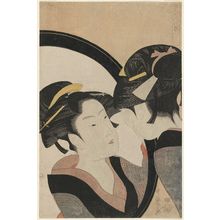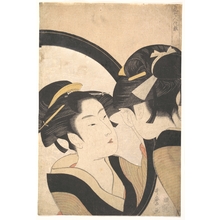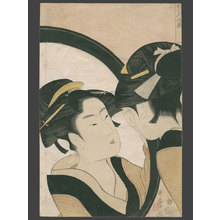喜多川歌麿による浮世絵「Okita」
作者:喜多川歌麿
作品名:Okita
制作年:c. 1789
詳細:詳細情報...
情報源:ホノルル美術館
浮世絵(全 5,476 件)を表示...
説明:
This print depicts Okita, the star waitress of the Naniwa-ya teahouse. The mirror reflects her beautiful face while her actual figure is depicted from behind. In Japan, the nape of a woman's neck is traditionally considered one of the most sensual areas of the body. Utamaro's attempt to depict feminine sensuality is superbly represented in this composition. The Kansei era (1789-1801) was a period of extensive governmental reforms and regulations such as the one affecting the identification of famous courtesans. When the corrupt Tanuma administration was purged by the new shögun lenari in 1787, he immediately emphasized samurai ideals and most importantly, a correction of popular customs. This resulted in a ban on luxury, decorations, toys, etc. In the fifth month of 1790, the realm of publishing and ukiyo-e was attacked first with a ban on erotica, and then in the ninth month, with a requirement for censorship approval. Various other attacks followed, including one forbidding the naming of popular entertainers. The above print falls into the category of a veiled picture, since the name of the beauty, Okita, was understood through the symbolic use of the paulownia crest. (from "VOGUE in Japan: Edo Fashion through Japanese prints" exhibition 07/30/08-)













